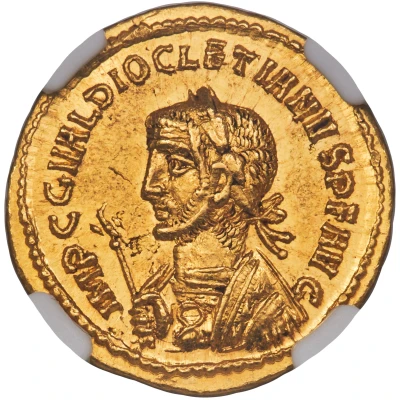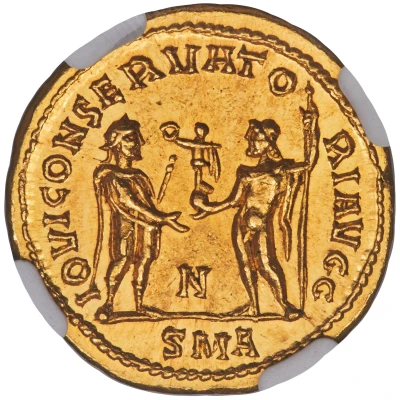


© Heritage Auctions
Aureus - Diocletian IOVI CONSERVATORI AVGG; Antioch
286 year| Gold | 6.33 g | 20 mm |
| Issuer | Rome › Roman Empire (27 BC - 395 AD) |
|---|---|
| Emperor | Diocletian (Gaius Aurelius Valerius Diocletianus) (284-305) |
| Type | Standard circulation coin |
| Year | 286 |
| Value | Aureus = 25 Denarii |
| Currency | Antoninianus, Reform of Caracalla (AD 215 – 301) |
| Composition | Gold |
| Weight | 6.33 g |
| Diameter | 20 mm |
| Shape | Round (irregular) |
| Technique | Hammered |
| Orientation | Variable alignment ↺ |
| Demonetized | Yes |
| Updated | 2024-10-05 |
| Numista | N#379991 |
|---|---|
| Rarity index | 100% |
Reverse
Diocletian standing facing in military dress, laureate head right, scepter in left hand, receiving with right Victory on globe left from Jupiter standing facing, nude bust for chlamys across shoulders, head left, grounded scepter in left hand; N (mark of value=50) in central field, SMA in exergue.
Script: Latin
Lettering:
IOVI CONSERVATO-RI AVGG
N
SMA
Unabridged legend: Iovi Conservatori Duorum Augustorum
Translation: To Jupiter, protector of the two emperors (Augusti)
Comment
RIC V.II -. Calicó -. Lukanc, Diokletianus, p. 152, 5 (Dumbarton Oaks, same reverse die). Depeyrot p. 138, 4 (Dumbarton Oaks).Two specimens known.
Otto Seeck and Karl Pink, in "Die Goldprägung des Diocletianus und seiner Mitregenten," NZ 64 (1931), pp. 57-58," correctly hypothesized the mark in the central field on this very rare issue designated the weight standard of 50 to the Roman pound (6.40 gm standard), as compared to the O issues (1/70=4.60 gm) and later X, Ξ, and Σ issues (1/60=5.30 gm).
Interesting fact
One interesting fact about the Aureus - Diocletian (IOVI CONSERVATORI AVGG; Antioch) (286) coin is that it features an image of the Roman god Jupiter on one side, and an image of the emperor Diocletian on the other. This coin was minted during Diocletian's reign (284-305 AD) and was used as a form of currency throughout the Roman Empire. The coin's design was meant to symbolize the connection between the Roman state and the divine, with Jupiter representing the supreme god of the Roman pantheon and Diocletian representing the earthly authority of the emperor.